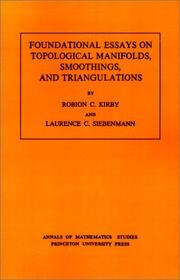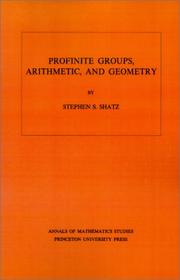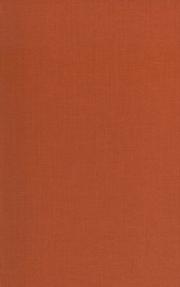| Listing 1 - 4 of 4 |
Sort by
|
Book
ISBN: 9780691140490 9780691140483 0691140480 0691140499 9786612644955 1400830559 1282644955 9781400830558 9781282644953 6612644958 Year: 2009 Volume: 170 Publisher: Princeton, N.J. Princeton University Press
Abstract | Keywords | Export | Availability | Bookmark
 Loading...
Loading...Choose an application
- Reference Manager
- EndNote
- RefWorks (Direct export to RefWorks)
Higher category theory is generally regarded as technical and forbidding, but part of it is considerably more tractable: the theory of infinity-categories, higher categories in which all higher morphisms are assumed to be invertible. In Higher Topos Theory, Jacob Lurie presents the foundations of this theory, using the language of weak Kan complexes introduced by Boardman and Vogt, and shows how existing theorems in algebraic topology can be reformulated and generalized in the theory's new language. The result is a powerful theory with applications in many areas of mathematics. The book's first five chapters give an exposition of the theory of infinity-categories that emphasizes their role as a generalization of ordinary categories. Many of the fundamental ideas from classical category theory are generalized to the infinity-categorical setting, such as limits and colimits, adjoint functors, ind-objects and pro-objects, locally accessible and presentable categories, Grothendieck fibrations, presheaves, and Yoneda's lemma. A sixth chapter presents an infinity-categorical version of the theory of Grothendieck topoi, introducing the notion of an infinity-topos, an infinity-category that resembles the infinity-category of topological spaces in the sense that it satisfies certain axioms that codify some of the basic principles of algebraic topology. A seventh and final chapter presents applications that illustrate connections between the theory of higher topoi and ideas from classical topology.
Algebraic geometry --- Topology --- Toposes --- Categories (Mathematics) --- Categories (Mathematics). --- Toposes. --- Algebra --- Mathematics --- Physical Sciences & Mathematics --- Category theory (Mathematics) --- Topoi (Mathematics) --- Algebra, Homological --- Algebra, Universal --- Group theory --- Logic, Symbolic and mathematical --- Functor theory --- Adjoint functors. --- Associative property. --- Base change map. --- Base change. --- CW complex. --- Canonical map. --- Cartesian product. --- Category of sets. --- Category theory. --- Coequalizer. --- Cofinality. --- Coherence theorem. --- Cohomology. --- Cokernel. --- Commutative property. --- Continuous function (set theory). --- Contractible space. --- Coproduct. --- Corollary. --- Derived category. --- Diagonal functor. --- Diagram (category theory). --- Dimension theory (algebra). --- Dimension theory. --- Dimension. --- Enriched category. --- Epimorphism. --- Equivalence class. --- Equivalence relation. --- Existence theorem. --- Existential quantification. --- Factorization system. --- Functor category. --- Functor. --- Fundamental group. --- Grothendieck topology. --- Grothendieck universe. --- Group homomorphism. --- Groupoid. --- Heyting algebra. --- Higher Topos Theory. --- Higher category theory. --- Homotopy category. --- Homotopy colimit. --- Homotopy group. --- Homotopy. --- I0. --- Inclusion map. --- Inductive dimension. --- Initial and terminal objects. --- Inverse limit. --- Isomorphism class. --- Kan extension. --- Limit (category theory). --- Localization of a category. --- Maximal element. --- Metric space. --- Model category. --- Monoidal category. --- Monoidal functor. --- Monomorphism. --- Monotonic function. --- Morphism. --- Natural transformation. --- Nisnevich topology. --- Noetherian topological space. --- Noetherian. --- O-minimal theory. --- Open set. --- Power series. --- Presheaf (category theory). --- Prime number. --- Pullback (category theory). --- Pushout (category theory). --- Quillen adjunction. --- Quotient by an equivalence relation. --- Regular cardinal. --- Retract. --- Right inverse. --- Sheaf (mathematics). --- Sheaf cohomology. --- Simplicial category. --- Simplicial set. --- Special case. --- Subcategory. --- Subset. --- Surjective function. --- Tensor product. --- Theorem. --- Topological space. --- Topology. --- Topos. --- Total order. --- Transitive relation. --- Universal property. --- Upper and lower bounds. --- Weak equivalence (homotopy theory). --- Yoneda lemma. --- Zariski topology. --- Zorn's lemma.

ISBN: 0691081905 0691081913 1400881501 9780691081908 Year: 1977 Volume: no. 88 Publisher: Princeton, N.J.
Abstract | Keywords | Export | Availability | Bookmark
 Loading...
Loading...Choose an application
- Reference Manager
- EndNote
- RefWorks (Direct export to RefWorks)
Since Poincaré's time, topologists have been most concerned with three species of manifold. The most primitive of these--the TOP manifolds--remained rather mysterious until 1968, when Kirby discovered his now famous torus unfurling device. A period of rapid progress with TOP manifolds ensued, including, in 1969, Siebenmann's refutation of the Hauptvermutung and the Triangulation Conjecture. Here is the first connected account of Kirby's and Siebenmann's basic research in this area.The five sections of this book are introduced by three articles by the authors that initially appeared between 1968 and 1970. Appendices provide a full discussion of the classification of homotopy tori, including Casson's unpublished work and a consideration of periodicity in topological surgery.
Differential geometry. Global analysis --- Manifolds (Mathematics) --- Piecewise linear topology --- Triangulating manifolds --- Variétés (Mathématiques) --- Topologie linéaire par morceaux --- 515.16 --- Manifolds, Triangulating --- PL topology --- Topology --- Geometry, Differential --- Topology of manifolds --- Piecewise linear topology. --- Triangulating manifolds. --- Manifolds (Mathematics). --- 515.16 Topology of manifolds --- Variétés (Mathématiques) --- Topologie linéaire par morceaux --- Triangulation. --- Triangulation --- Affine space. --- Algebraic topology (object). --- Approximation. --- Associative property. --- Automorphism. --- Big O notation. --- CW complex. --- Calculation. --- Cap product. --- Cartesian product. --- Category of sets. --- Chain complex. --- Classification theorem. --- Classifying space. --- Cobordism. --- Codimension. --- Cofibration. --- Cohomology. --- Connected space. --- Continuous function (set theory). --- Continuous function. --- Counterexample. --- Diffeomorphism. --- Differentiable manifold. --- Differential structure. --- Differential topology. --- Dimension (vector space). --- Direct proof. --- Disjoint union. --- Elementary proof. --- Embedding. --- Euclidean space. --- Existence theorem. --- Existential quantification. --- Fiber bundle. --- Fibration. --- General position. --- Geometry. --- Group homomorphism. --- H-cobordism. --- H-space. --- Handle decomposition. --- Handlebody. --- Hauptvermutung. --- Hausdorff space. --- Hilbert cube. --- Homeomorphism group. --- Homeomorphism. --- Homomorphism. --- Homotopy group. --- Homotopy. --- Inclusion map. --- Injective function. --- Invertible matrix. --- K-cell (mathematics). --- Kan extension. --- Linear subspace. --- Linear topology. --- Manifold. --- Mapping cylinder. --- Mathematical induction. --- Mathematician. --- Metric space. --- Morse theory. --- Neighbourhood (mathematics). --- Open set. --- Partition of unity. --- Piecewise linear manifold. --- Piecewise linear. --- Poincaré conjecture. --- Polyhedron. --- Principal bundle. --- Product metric. --- Pushout (category theory). --- Regular homotopy. --- Retract. --- Sheaf (mathematics). --- Simplicial complex. --- Smoothing. --- Spin structure. --- Stability theory. --- Stable manifold. --- Standard map. --- Submanifold. --- Submersion (mathematics). --- Subset. --- Surgery exact sequence. --- Surjective function. --- Theorem. --- Topological group. --- Topological manifold. --- Topological space. --- Topology. --- Transversal (geometry). --- Transversality (mathematics). --- Transversality theorem. --- Union (set theory). --- Uniqueness theorem. --- Vector bundle. --- Zorn's lemma. --- Variétés topologiques

ISBN: 0691080178 1400881854 9780691080178 Year: 1972 Volume: 67 Publisher: Princeton, N.J.
Abstract | Keywords | Export | Availability | Bookmark
 Loading...
Loading...Choose an application
- Reference Manager
- EndNote
- RefWorks (Direct export to RefWorks)
In this volume, the author covers profinite groups and their cohomology, Galois cohomology, and local class field theory, and concludes with a treatment of duality. His objective is to present effectively that body of material upon which all modern research in Diophantine geometry and higher arithmetic is based, and to do so in a manner that emphasizes the many interesting lines of inquiry leading from these foundations.
Group theory --- Finite groups --- Algebraic number theory --- 512.73 --- 512.66 --- Homology theory --- Number theory --- Cohomology theory --- Contrahomology theory --- Algebraic topology --- Groups, Finite --- Modules (Algebra) --- Cohomology theory of algebraic varieties and schemes --- Homological algebra --- 512.66 Homological algebra --- 512.73 Cohomology theory of algebraic varieties and schemes --- Groupes, Théorie des. --- Group theory. --- Homology theory. --- Finite groups. --- Algebraic number theory. --- Abelian group. --- Alexander Grothendieck. --- Algebraic closure. --- Algebraic extension. --- Algebraic geometry. --- Algebraic number field. --- Brauer group. --- Category of abelian groups. --- Category of sets. --- Characterization (mathematics). --- Class field theory. --- Cohomological dimension. --- Cohomology. --- Cokernel. --- Commutative diagram. --- Composition series. --- Computation. --- Connected component (graph theory). --- Coset. --- Cup product. --- Dedekind domain. --- Degeneracy (mathematics). --- Diagram (category theory). --- Dimension (vector space). --- Diophantine geometry. --- Discrete group. --- Equivalence of categories. --- Exact sequence. --- Existential quantification. --- Explicit formula. --- Exponential function. --- Family of sets. --- Field extension. --- Finite group. --- Fundamental class. --- G-module. --- Galois cohomology. --- Galois extension. --- Galois group. --- Galois module. --- Galois theory. --- General topology. --- Geometry. --- Grothendieck topology. --- Group cohomology. --- Group extension. --- Group scheme. --- Hilbert symbol. --- Hopf algebra. --- Ideal (ring theory). --- Inequality (mathematics). --- Injective sheaf. --- Inner automorphism. --- Inverse limit. --- Kummer theory. --- Lie algebra. --- Linear independence. --- Local field. --- Mathematical induction. --- Mathematician. --- Mathematics. --- Module (mathematics). --- Morphism. --- Natural topology. --- Neighbourhood (mathematics). --- Normal extension. --- Normal subgroup. --- Number theory. --- P-adic number. --- P-group. --- Polynomial. --- Pontryagin duality. --- Power series. --- Prime number. --- Principal ideal. --- Profinite group. --- Quadratic reciprocity. --- Quotient group. --- Ring of integers. --- Sheaf (mathematics). --- Special case. --- Subcategory. --- Subgroup. --- Supernatural number. --- Sylow theorems. --- Tangent space. --- Theorem. --- Topological group. --- Topological property. --- Topological ring. --- Topological space. --- Topology. --- Torsion group. --- Torsion subgroup. --- Transcendence degree. --- Triviality (mathematics). --- Unique factorization domain. --- Variable (mathematics). --- Vector space. --- Groupes, Théorie des --- Nombres, Théorie des

ISBN: 0691082383 1400883989 Year: 1980 Publisher: Princeton, N.J.
Abstract | Keywords | Export | Availability | Bookmark
 Loading...
Loading...Choose an application
- Reference Manager
- EndNote
- RefWorks (Direct export to RefWorks)
One of the most important mathematical achievements of the past several decades has been A. Grothendieck's work on algebraic geometry. In the early 1960s, he and M. Artin introduced étale cohomology in order to extend the methods of sheaf-theoretic cohomology from complex varieties to more general schemes. This work found many applications, not only in algebraic geometry, but also in several different branches of number theory and in the representation theory of finite and p-adic groups. Yet until now, the work has been available only in the original massive and difficult papers. In order to provide an accessible introduction to étale cohomology, J. S. Milne offers this more elementary account covering the essential features of the theory. The author begins with a review of the basic properties of flat and étale morphisms and of the algebraic fundamental group. The next two chapters concern the basic theory of étale sheaves and elementary étale cohomology, and are followed by an application of the cohomology to the study of the Brauer group. After a detailed analysis of the cohomology of curves and surfaces, Professor Milne proves the fundamental theorems in étale cohomology -- those of base change, purity, Poincaré duality, and the Lefschetz trace formula. He then applies these theorems to show the rationality of some very general L-series.Originally published in 1980.The Princeton Legacy Library uses the latest print-on-demand technology to again make available previously out-of-print books from the distinguished backlist of Princeton University Press. These editions preserve the original texts of these important books while presenting them in durable paperback and hardcover editions. The goal of the Princeton Legacy Library is to vastly increase access to the rich scholarly heritage found in the thousands of books published by Princeton University Press since its founding in 1905.
Ordered algebraic structures --- 512.73 --- 512.66 --- Geometry, Algebraic --- Homology theory --- Sheaf theory --- Cohomology, Sheaf --- Sheaf cohomology --- Sheaves, Theory of --- Sheaves (Algebraic topology) --- Algebraic topology --- Cohomology theory --- Contrahomology theory --- Algebraic geometry --- Geometry --- Cohomology theory of algebraic varieties and schemes --- Homological algebra --- Geometry, Algebraic. --- Homology theory. --- Sheaf theory. --- 512.66 Homological algebra --- 512.73 Cohomology theory of algebraic varieties and schemes --- Abelian category. --- Abelian group. --- Adjoint functors. --- Affine variety. --- Alexander Grothendieck. --- Algebraic closure. --- Algebraic cycle. --- Algebraic equation. --- Algebraic space. --- Algebraically closed field. --- Artinian. --- Automorphism. --- Base change. --- Brauer group. --- CW complex. --- Cardinal number. --- Category of sets. --- Central simple algebra. --- Chow's lemma. --- Closed immersion. --- Codimension. --- Cohomology ring. --- Cohomology. --- Cokernel. --- Commutative diagram. --- Complex number. --- Dedekind domain. --- Derived category. --- Diagram (category theory). --- Direct limit. --- Discrete valuation ring. --- Divisor. --- Epimorphism. --- Equivalence class. --- Existential quantification. --- Fibration. --- Field of fractions. --- Fine topology (potential theory). --- Finite field. --- Finite morphism. --- Flat morphism. --- Functor. --- Fundamental class. --- Fundamental group. --- G-module. --- Galois cohomology. --- Galois extension. --- Galois group. --- Generic point. --- Group scheme. --- Gysin sequence. --- Henselian ring. --- Identity element. --- Inclusion map. --- Integral domain. --- Intersection (set theory). --- Inverse limit. --- Invertible sheaf. --- Isomorphism class. --- Lefschetz pencil. --- Local ring. --- Maximal ideal. --- Module (mathematics). --- Morphism of schemes. --- Morphism. --- Noetherian. --- Open set. --- Power series. --- Presheaf (category theory). --- Prime ideal. --- Prime number. --- Principal homogeneous space. --- Profinite group. --- Projection (mathematics). --- Projective variety. --- Quasi-compact morphism. --- Residue field. --- Riemann surface. --- Sheaf (mathematics). --- Sheaf of modules. --- Special case. --- Spectral sequence. --- Stein factorization. --- Subalgebra. --- Subcategory. --- Subgroup. --- Subring. --- Subset. --- Surjective function. --- Tangent space. --- Theorem. --- Topological space. --- Topology. --- Torsion sheaf. --- Torsor (algebraic geometry). --- Vector bundle. --- Weil conjecture. --- Yoneda lemma. --- Zariski topology. --- Zariski's main theorem. --- Geometrie algebrique --- Cohomologie
| Listing 1 - 4 of 4 |
Sort by
|

 Search
Search Feedback
Feedback About UniCat
About UniCat  Help
Help News
News